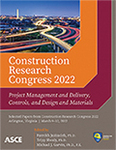Identification of Management Processes That Impact Capital Efficiency on Downstream and Chemical Projects
Publication: Construction Research Congress 2022
ABSTRACT
For companies trying to evaluate their capital deployment and return on investment, an important performance metric is capital efficiency. When defining and assessing capital efficiency, though, researchers face a common challenge—how to do so in a consistent way. Capital projects in the downstream and chemicals sector require significant capital expenditures to develop. The revenue generated from these projects is directly impacted by how they operate. In other words, the development of a project and its subsequent operation have an impact on the efficiency of the capital invested. Thus, it is important to address and improve capital efficiency at the project level. Researchers in this study reviewed the literature and interviewed industry professionals to explore how their organizations define and assess capital efficiency. The research team used a focus group to develop a pathway to identify management processes that, if implemented effectively, lead to efficient capital deployment in downstream and chemical projects.
Get full access to this article
View all available purchase options and get full access to this chapter.
REFERENCES
Beck, S. (2018). Haynesville Thriving On Capital Efficiency. Oil & Gas Investor, 38(12), 1.
Biddle, G. C., Hilary, G., and Verdi, R. S. (2009). How does financial reporting quality relate to investment efficiency? Journal of Accounting and Economics, 60(1), 99–334. https://doi.org/10.1016/j.jacceco.2009.09.001.
Caletka, A. (2016). Driving capital efficiency to fuel oil and gas projects - Capital projects and infrastructure: Energy. Petroleum Accounting and Financial Management Journal, 35(3), 86–95.
Clews, R. J. (2016). Finance Structures for Upstream, Midstream and Downstream Projects. In Project Finance for the International Petroleum Industry (pp. 337–364). Elsevier. https://doi.org/10.1016/b978-0-12-800158-5.00018-9.
Cutillas Gomariz, M. F., and Sánchez Ballesta, J. P. (2014). Financial reporting quality, debt maturity and investment efficiency. Journal of Banking and Finance, 40(1), 494–506. https://doi.org/10.1016/j.jbankfin.2013.07.013.
EnerCom. (2018). Drilling Down into Oil & Gas Valuation. Denver, CO.
Fang, T., and Lahdelma, R. (2016). Optimization of combined heat and power production with heat storage based on sliding time window method. Applied Energy, 162, 723–732. https://doi.org/10.1016/j.apenergy.2015.10.135.
Gao, R., and Yu, X. (2020). How to measure capital investment efficiency: a literature synthesis. Accounting and Finance, 60(1), 299–334. https://doi.org/10.1111/acfi.12343.
Goedhart, M., Levy, C., and Morgan, P. (2015). A better way to understand internal rate of return. McKinsey & Company, 6–12.
Hamilton, A., Koelman, J., and Vermeltfoort, K. (2019). Improving oil and gas project management. Retrieved April 24, 2021, from https://www.mckinsey.com/industries/oil-and-gas/our-insights/how-the-oil-and-gas-industry-can-improve-capital-project-performance.
Hartung, J. (2020). How to unlock value in oil and gas capital projects in any environment | EY - Global. Retrieved May 4, 2021, from https://www.ey.com/en_gl/oil-gas-digital-skills-survey/how-to-unlock-value-in-oil-and-gas-capital-projects-in-any-environment.
Hayes, A. (2021, February 18). Return on Capital Employed (ROCE) Definition. Retrieved August 19, 2021, from https://www.investopedia.com/terms/r/roce.asp.
Hwang, B. G., Tan, H. F., and Sathish, S. (2013). Capital project performance measurement and benchmarking in Singapore. Engineering, Construction and Architectural Management, 20(2), 143–159. https://doi.org/10.1108/09699981311303017.
Johnson, D., and Chang, R. (2018). Crude oil-to-chemicals projects presage a new era in global petrochemical industry. Chemical & Energy Insights, 16.
Jones, D., and Pujadó, P. (Eds.). (2006). Handbook of Petroleum Processing. Handbook of Petroleum Processing (1st ed.). Dordrecht, The Netherlands: Springer. https://doi.org/10.1007/1-4020-2820-2.
Kim, S. T., and Choi, B. (2019). Price risk management and capital structure of oil and gas project companies: Difference between upstream and downstream industries. Energy Economics, 83, 361–374. https://doi.org/10.1016/j.eneco.2019.07.008.
Kissi, J., Dainty, A., and Tuuli, M. (2013). Examining the role of transformational leadership of portfolio managers in project performance. International Journal of Project Management, 31(4), 485–497. https://doi.org/10.1016/j.ijproman.2012.09.004.
Langerak, F., Griffin, A., and Hultink, E. J. (2010). Balancing development costs and sales to optimize the development time of product line additions. Journal of Product Innovation Management, 27(3), 336–348. https://doi.org/10.1111/j.1540-5885.2010.00720.x.
McDonald, M. (2019). Valuation in the Oil & Gas Industry Report #6: Everything You Need To Know To Put A Realistic Value On Your Investment.
PMI. (2017). PMBOK Guide | Project Management Institute. PMBOK Guide.
Prieto, B. (2014). Capital Efficiency: Pull all the Levers (1st ed.). McLean, VA: CMAA.
PwC. (2015). Maximizing capital efficiency for your oil and gas projects. Retrieved May 4, 2021, from https://www.pwc.com/us/en/industries/capital-projects-infrastructure/oil-and-gas-capital-projects.html.
Ramsey, J. B. (1970). The Marginal Efficiency of Capital, the Internal Rate of Return, and Net Present Value: An Analysis of Investment Criteria. Journal of Political Economy, 78(5), 1017–1027. https://doi.org/10.1086/259687.
Satapathy, M. (2019). Beating volatility in exploration and production | Accenture. Retrieved May 4, 2021, from https://www.accenture.com/us-en/insights/strategy/energy-portfolio-management.
Scott-Young, C., and Samson, D. (2008). Project success and project team management: Evidence from capital projects in the process industries. Journal of Operations Management, 26(6), 749–766. https://doi.org/10.1016/j.jom.2007.10.006.
Shah, R. (2012). Thinking about tomorrow: capital efficiency in the GCC.
Sheehan, C. (2017). On The Money: Raising or Reining in Outspends? Oil & Gas Investor, 37(4).
Shell. (2021). Performance indicators - Shell Annual Report 2020. Retrieved from https://reports.shell.com/annual-report/2020/strategic-report/performance-indicators.php.
STI Group. (2013). Oil and Gas Energy Markets: What Is Downstream? Retrieved May 14, 2021, from https://setxind.com/downstream/oil-and-gas-energy-what-is-downstream/.
Talerico, A. (2020, August 24). Why Capital Efficiency Matters. Retrieved August 19, 2021, from https://www.arthurventures.com/blog/why-capital-efficiency-matters.
Wang, P., and AbouRizk, S. M. (2009). Large-scale simulation modeling system for industrial construction. Canadian Journal of Civil Engineering, 36(9), 1517–1529. https://doi.org/10.1139/L09-094.
Yun, S. (2013). The impact of the business-project interface on capital project performance. The University of Texas at Austin.
Information & Authors
Information
Published In
History
Published online: Mar 7, 2022
Authors
Metrics & Citations
Metrics
Citations
Download citation
If you have the appropriate software installed, you can download article citation data to the citation manager of your choice. Simply select your manager software from the list below and click Download.
